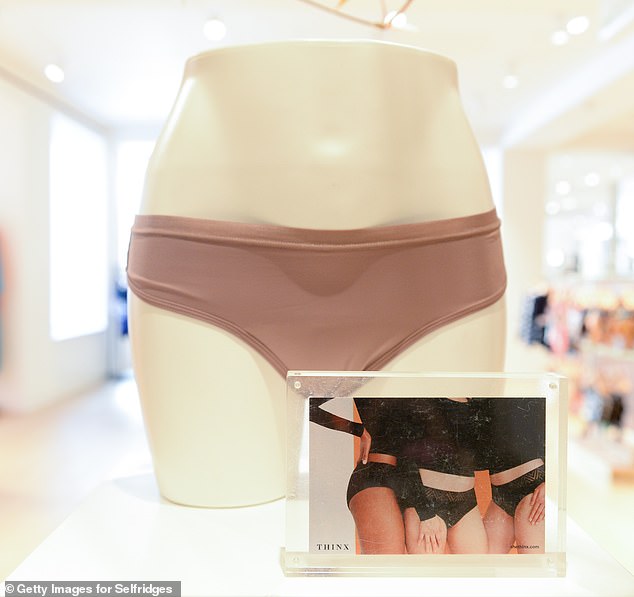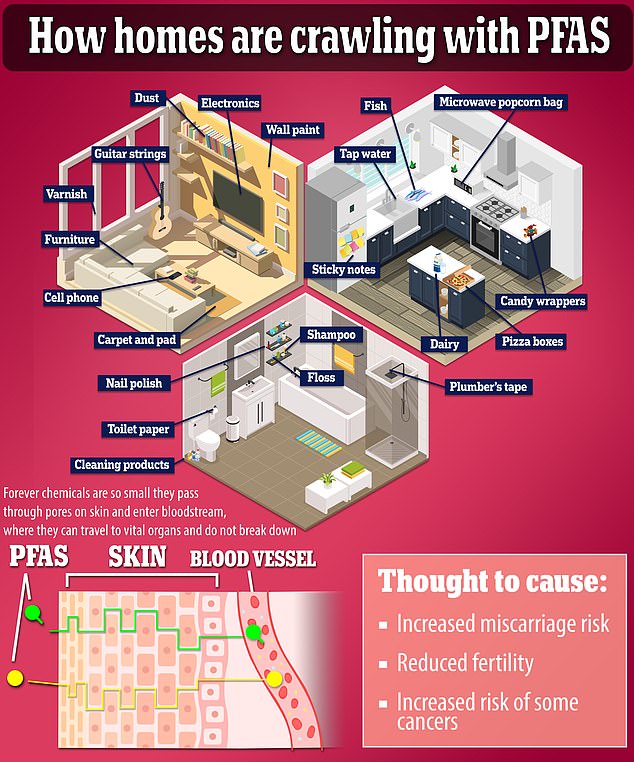Cancer-causing chemicals found in BAND-AIDS, where they can enter the blood directly through open wounds, report warns
Bandages from some of the most renowned brands, including Band-Aid and Curad, contain dangerous levels of forever chemicals, a shocking report has revealed.
Tests by a leading watchdog have found the chemical fluorine is present in more than 20 different dressings found in millions of medicine cabinets across the country.
PFAS chemicals are sometimes used to make adhesives, and researchers believe these are products of the normal manufacturing process. Fluorine, which is also used to make rocket fuel, can cause skin burns and eye damage, but is most dangerous when inhaled.
Dr. Linda Birnbaum, a toxicologist and former head of the National Toxicology Program who co-led the lab tests, said the fact that risky chemicals come into direct contact with open wounds was “concerning.”
PFAS chemicals can easily enter the bloodstream after someone drinks water or eats food laced with them. Once in the bloodstream, PFAS can lodge in healthy tissue, where it can damage the immune system, liver, kidneys and other organs.
Four types of household bandages contain more than 180 parts per million of organic fluoride, a critical component of PFAS forever chemicals

Thinx underwear and other historical products were found to contain tens to more than 100 parts per million of the compound
Environmental watchdogs had 40 dressings from 18 different brands tested for fluorine, and detectable levels were found in 26 of them.
Consumer watchdog blog Mamavation and Environmental Health News used an EPA-certified laboratory to look for PFAS chemicals in the absorbent sanitary napkins and adhesive flaps of bandages sold at major retailers including CVS, Walmart, Rite Aid, Target and Amazon.
The dressings containing high fluoride levels of more than 100 parts per million include brands Band-Aid, Care Science, Curad, CVS Health, Equate, First Honey, Rite Aid brand, Solimo (Amazon brand) and Up & Up, Target’s brand.
Dr. Birnbaum said: ‘Because bandages are applied to open wounds, it is troubling to hear that they may also expose children and adults to PFAS.
‘The data clearly shows that PFAS are not necessary for wound care, so it is important that industry removes their presence to protect the public from PFAS and instead opts for PFAS-free materials.’
PFAS substances contain bonds between carbon and fluorine atoms, creating a highly resilient chemical that can remain in the environment for years or even decades.
The chemicals are everywhere, usually in water and stain repellent products, but also in nonstick cookware.
Teflon, the kitchen’s nonstick coating, is made with a fluorocarbon called polytetrafluoroethylene (PTFE).
PFAS have also been found in tap water and human blood. A report from the Centers for Disease Control and Prevention National Health and Nutrition Examination Survey (NHANES) found that PFAS was in the blood of 97 percent of Americans.
According to Mamavation, PFAS are likely used in bandages because of their water and oil-repellent properties.

PFAS is a common contaminant in many household items, from cookware to hamburger wrappers. It can remain in the environment and in human tissue for years, even decades, before being cleared
In addition, PFAS has also been found in popular menstrual products, including those typically used by teenage girls.
Jessian Choy, who worked at the Department of the Environment in San Francisco, chose to lab test her favorite brand of Thinx briefs and BTWN Shorty underwear.
The tests were conducted in 2020 by Dr. Graham Peaslee, who discovered PFAS chemicals in fast food packaging in 2017, at the University of Notre Dame.
The ‘organic’ products contain a high PFAS content. Thinx had 3,264 parts per million (ppm) and the BTW for teens was 2,053 ppm.
They also had tens to hundreds of parts per million copper on the inside of the cross and zinc on both sides.
The investigation generated bad publicity for Thinx, which would later settle a class action lawsuit for approximately $5 million. The company refuted the findings and urged Dr. Peaslee states that their products do not contain PFAS.
Dr. Peaslee said The hill: ‘They called me back and said, “Well, this thing is getting out of hand, can you just issue a statement saying they’re safe to wear?” And I thought, ‘I’m sorry, didn’t you listen to a word I said yesterday? I wouldn’t put my damn daughter in these things.”
Period underwear is far from the only menstrual products loaded with PFAS. A separate series of laboratory analyses in 2020 and 2022, Mamavation and Environmental Health News examined 46 different sanitary napkins, panty liners and incontinence pads for evidence of PFAS.
Fluoride was found in 22 of them, or 48 percent.
Dr. Birnbaum said: ‘Skin exposure to PFAS from menstrual products can be a major problem. Because the vaginal skin is so vascular, we can expect that internal exposure may be slightly worse.”
The effects of skin exposure to PFAS chemicals are not yet well understood, although fluoride exposure can cause serious skin irritation.
Pete Myers, chief scientist at Environmental Health Sciences at Carnegie Mellon University, told Mamavation: ‘While it is not possible today to answer the question of how much can be absorbed through the skin, we do know that any potential exposure should be avoided . PFAS should not be in consumer products, period!’
